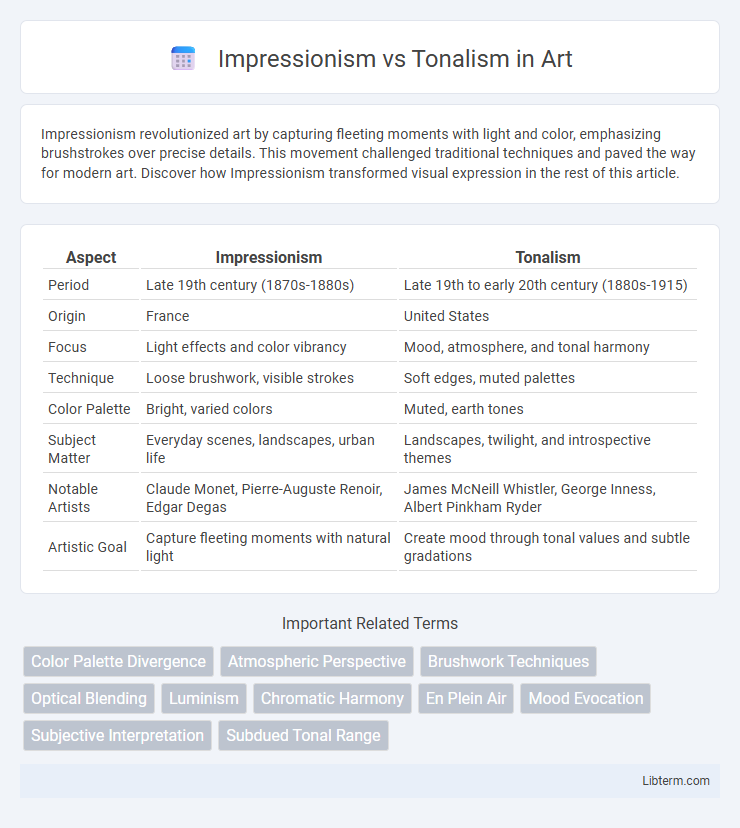Impressionism revolutionized art by capturing fleeting moments with light and color, emphasizing brushstrokes over precise details. This movement challenged traditional techniques and paved the way for modern art. Discover how Impressionism transformed visual expression in the rest of this article.
Table of Comparison
| Aspect | Impressionism | Tonalism |
|---|---|---|
| Period | Late 19th century (1870s-1880s) | Late 19th to early 20th century (1880s-1915) |
| Origin | France | United States |
| Focus | Light effects and color vibrancy | Mood, atmosphere, and tonal harmony |
| Technique | Loose brushwork, visible strokes | Soft edges, muted palettes |
| Color Palette | Bright, varied colors | Muted, earth tones |
| Subject Matter | Everyday scenes, landscapes, urban life | Landscapes, twilight, and introspective themes |
| Notable Artists | Claude Monet, Pierre-Auguste Renoir, Edgar Degas | James McNeill Whistler, George Inness, Albert Pinkham Ryder |
| Artistic Goal | Capture fleeting moments with natural light | Create mood through tonal values and subtle gradations |
Introduction to Impressionism and Tonalism
Impressionism emerged in the late 19th century as an art movement characterized by loose brushwork, vibrant colors, and an emphasis on capturing natural light and fleeting moments. Tonalism, developing slightly later, focused on mood and atmosphere through muted color palettes and soft, blended tones to evoke a sense of tranquility and introspection. Both movements influenced landscape painting but diverged in their approach to color intensity and emotional expression.
Historical Context and Origins
Impressionism emerged in the late 19th century France, influenced by the rapid industrialization and urbanization that fostered a desire to capture fleeting moments and light effects in outdoor scenes. Tonalism developed shortly after in America during the 1880s, reflecting a reaction to the harsh realities of industrial growth by emphasizing mood and shadow through a limited color palette. Both movements sought to break from traditional academic art, with Impressionism focusing on vivid color and light while Tonalism prioritized atmosphere and subtle tonal gradations.
Key Philosophies and Artistic Intent
Impressionism centers on capturing fleeting moments of light and color through spontaneous brushstrokes, emphasizing sensory experience over detailed realism. Tonalism prioritizes mood and atmosphere by using muted color palettes and soft, blended tones to evoke emotional depth and poetic contemplation. Both movements seek to express perception, but Impressionism highlights visual sensation, whereas Tonalism focuses on introspective ambiance.
Signature Techniques and Brushwork
Impressionism features loose, rapid brushstrokes that capture light and color variations, emphasizing atmosphere and momentary effects. Tonalism employs smooth, blended brushwork with a limited palette to create moody, atmospheric landscapes dominated by subtle tonal gradations. Impressionist painters like Monet favored broken color and visible strokes, whereas Tonalists such as Whistler prioritized tonal harmony and softness in their brush application.
Use of Color and Light
Impressionism emphasizes vibrant, fragmented strokes of pure color to capture the fleeting effects of natural light, often portraying outdoor scenes with high contrast and dynamic luminosity. Tonalism employs a more subdued and harmonious palette, using muted colors and soft transitions to evoke mood and atmosphere through diffused light and shadow. The contrast lies in Impressionism's focus on vivid color interplay and immediate visual impressions versus Tonalism's emphasis on tonal harmony and subtle gradations of light.
Depiction of Nature and Landscapes
Impressionism captures nature through vibrant, dynamic brushstrokes and a focus on changing light and color, emphasizing atmospheric effects and moments in time. Tonalism presents landscapes with muted tones and soft, diffuse light, creating a moody, introspective ambiance that highlights mood over detail. Both movements depict nature but differ in their approach to color intensity and emotional resonance.
Influential Artists in Each Movement
Impressionism featured influential artists such as Claude Monet, Pierre-Auguste Renoir, and Edgar Degas, who emphasized light, color, and brushstroke to capture fleeting moments in nature. Tonalism, with key figures like James McNeill Whistler, George Inness, and Albert Pinkham Ryder, focused on mood and atmosphere using muted color palettes and subtle gradations of tone. These artists shaped the distinct aesthetics and philosophies of their respective movements through innovative techniques and thematic explorations.
Comparative Analysis of Notable Works
Impressionism, exemplified by Claude Monet's "Water Lilies," captures fleeting light and vibrant colors with loose, quick brushstrokes that emphasize natural light effects. Tonalism, seen in James McNeill Whistler's "Nocturne in Black and Gold," employs subdued color palettes and soft, misty atmospheres to evoke mood and introspection. Where Impressionism focuses on visual perception and momentary scenes, Tonalism prioritizes emotional tone and subtle gradations of color to create a contemplative experience.
Lasting Impact on Modern Art
Impressionism revolutionized modern art with its emphasis on light, color, and spontaneous brushwork, influencing countless contemporary artists and movements such as Fauvism and Abstract Expressionism. Tonalism, characterized by its mood-driven, muted palettes and focus on atmosphere, contributed significantly to the development of American landscape painting and the later rise of modern minimalism. The lasting impact of both styles is evident in how they shifted artistic focus from detailed realism to emotional expression and experiential perception.
Conclusion: Impressionism vs Tonalism
Impressionism emphasizes vibrant colors, light effects, and fleeting moments to capture the sensory experience of a scene, while Tonalism prioritizes muted tones, subtle gradations, and atmospheric mood to evoke emotion and introspection. Both movements revolutionized landscape painting but differ fundamentally in their use of color and light to communicate artistic vision. Understanding these contrasts highlights how Impressionism celebrates external reality whereas Tonalism conveys internal perception.
Impressionism Infographic

 libterm.com
libterm.com